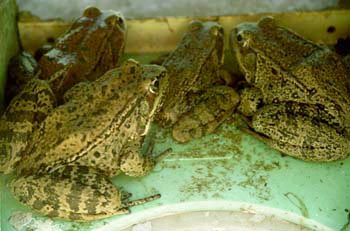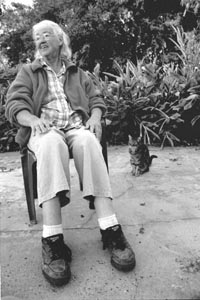![[MetroActive News&Issues]](/gifs/news468.gif)
[ Santa Cruz | MetroActive Central | Archives ]
 Photograph by Ivan Kashinsky The Littlest Victims: UCSC's faculty housing plans threaten valuable foraging habitat for the California red-legged frog. Road Kill UCSC is a key habitat for Mark Twain's celebrated jumping frogs. But UCSC Chancellor M.R.C. Greenwood seems intent on destroying it. By Jessica Lyons THE CELEBRATED jumping frogs of Santa Cruz County aren't doing much racing these days. Mark Twain immortalized their leggy ancestors in "The Celebrated Jumping Frog of Calaveras County," a story believed to have been inspired by the California red-legged frog, the largest native frog in the western United States. Nowadays, it's illegal to jump red-leggeds, or even to touch them. The hoppers have been on the decline since the early '90s at least and were listed as federally threatened--and therefore protected by the Endangered Species Act--in June 1996. They tend to disappear in urban settings in the vicinity of pesticides and herbicides. Roads are especially dangerous for the little buggers. U.S. Fish and Wildlife Service officials say that the UCSC Arboretum reservoir and the riparian habitat surrounding it are a key habitat and breeding site for the frogs. But even UCSC's frogs don't have much time to polish their hops lately. They're busy avoiding cars and bikes along Empire Grade, mud and silt runoff from the western campus and, perhaps most dangerous of all, UCSC Chancellor M.R.C. Greenwood as she bulldozes ahead with plans to build at least 80 housing units in the prime red-legged frog habitat. Frog enthusiasts and Arboretum and Farm and Garden Project volunteers say the housing plans--and accompanying access roads and pesticide-groomed lawns--threaten the red-legged frog population. UCSC officials, however, respond that's it's too early to talk about what--if anything--will be built on Inclusion Area D, a parcel located on Empire Grade, extending from the Farm and Arboretum to the western edge of the historic Cowell Ranch. But friends of the frogs worry that the proposed housing plans are more solid that UCSC reps are letting on. They worry the development will continue in standard Greenwood fashion, devastating all amphibians in its path.
Draft Recovery Plan For Red-legged Frogs
Frog Heaven? 'ONCE, red-legged frogs had a great time of it on campus because there were so many frog amenities," says Ray Collett, a longtime UCSC professor and former 30-year Arboretum director. "There were lots of things that kept frogs comfortable and happy--water troughs left over from the old Cowell Ranch, 'sympathy ponds' dug out by students--that made it easy for the adult red-legged frog to get out and live on dry land. Ken Norris, a famous herbologist and biologist, used to call the lower campus 'Frog Heaven,' and it really seemed to be a frog heaven." Times have changed. A stream once flowed through Jordan Gulch and down into the lower quarry, providing a wet escape from the dry sun for frogs. Now the stream is paved over, and student housing is being built. Student-made ponds have been filled and cattle troughs emptied--they were too much of a liability to the university. Traffic on Empire Grade and on unpaved roads that run between the Arboretum and Farm and Garden has increased, as has frog road-kill. It's slim pickings for the California red-legged frog, which ranges from 1.5 to 5 inches in length. Adult frogs are distinguished by olive, brown, gray or reddish bodies marked with small black flecks, and rusty-red color on their bellies and the undersides of their hind legs. But they have managed to stick around, breeding in the Arboretum reservoir and hopping east to the Farm and Garden and southwest across Empire Grade to forage for food--although students and volunteers say dead frogs on the side of the road are common. "They only spend their time as pollywogs in the ponds," Collett explains. "Adult frogs span out and live in the surrounding countryside. They need foraging habitat to look for food and to stay out of the hot dry sun. And of course, any pond of water is very helpful for them living out in the dry California summer." Collett, one of the first UCSC faculty and the original Arboretum director, still teaches horticulture, biogeography and meteorology at the university. But after about 30 years of Arboretum work, he stepped down in 1998--and up stepped interim director Ronald Enomoto, considered by many Arboretum volunteers not to have the best interests of the Arboretum at heart but rather to be a front man for Greenwood's development plans. He is currently involved in a marketing survey to determine what kind of housing the faculty wants--a curious role for an Arboretum director. In a past interview, Enomoto said the preferred entrance to the housing project would extend from Western Drive through the Arboretum's eucalyptus grove--a veritable deathtrap for the frogs, Collett says. "We've lost a great part of their foraging habitat and, moreover, the foraging habitat keeps getting broken up in other ways, by roads and pavement," Collett explains. "A poor frog has an awful time hopping across Empire Grade when the traffic is heavy." The frogs are mobile critters. Adult California red-legged frogs can travel up to two miles in one season, says John Bulger, a Davenport consulting wildlife biologist. "I wouldn't say that is uncommon," says Bulger, who has studied the terrestrial habitat of the threatened frogs. "I think it identifies average long-distance movement--it's not rare by any means." Leap of Faith THE ONLY CONFIRMED breeding site on campus is the Arboretum Pond, says Dawn Reis, a wildlife biologist at Ecosystems West Consulting Group. "It's been documented as a reproductive site, as is Antonelli Pond [located on the West Side of Santa Cruz, near Natural Bridges], which is part of the Moore Creek drainage," says Reis, who is currently completing a draft habitat assessment of California red-legged frog for the entire campus. The Arboretum population is an important one, biologists say, because it's located near the urban limit line.
Photograph by Ivan Kashinsky "To our knowledge, it's the most urban population on the northern side of Santa Cruz, so it represents an important population," says Fish and Wildlife Service ecologist Ivana Noell. "Maintaining that population means maintaining the opportunity for frogs to reestablish in creeks and in other suitable habitat in Santa Cruz. It also increases the chances of the survival and expansion of the regional population (of which the Arboretum frogs are a breeding sub-population) that extends up the coast to the north." It is critical that the pond not be cut off from other red-legged breeding sites--such as Wilder Creek to the north--and that sufficient numbers of frogs can continue to cross Empire Grade without becoming road kill, say biologists and Arboretum volunteers. Since the frog became federally listed in 1996, it has been illegal for anyone to "take" (including harass, collect, kill or injure) the little hoppers. There is a loophole, however. Property owners wishing to conduct potentially harmful activity on their property--building 80 housing units, for example--that might result in a "take" must obtain an "incidental take permit" from the U.S. Fish and Wildlife Service. To qualify for such a permit, the applicant must first develop a Habitat Conservation Plan. It's an applicant-driven process, Noell explains. "The project is in the applicant's court," she says. "They make the determination [whether or not 'take' will occur], and they prepare the HCP. Once the HCP is completed, they can submit an application for an incidental 'take' permit." Once the applicant submits the formal application--including the Habitat Conservation Plan--the ball lands in the Fish and Wildlife Service's court, which reviews the application and the HCP for completeness. Before Fish and Wildlife issues a permit, however, the process is opened to the public for review. Noell confirms that UCSC officials have contacted the Fish and Wildlife Service requesting informational material about Habitat Conservation Plans. UCSC officials did not return numerous phone calls requesting comment. Froggie Fatalities THE ENDANGERED Species Act allows room for accidents, such as hitting a highway-bound frog or accidentally hooking one while fishing. Accidents aside, the act spells out an even longer list of illegal actions that could potentially harm the frog and result in an incidental "take," including "unauthorized destruction/alteration of the species habitat," "pesticide applications in violation of label restrictions," and "discharges or dumping of toxic chemicals, silt or other pollutants into water, or riparian and upland habitats supporting the species." According to Arboretum frog enthusiasts, the university does all of the above. Western campus runoff--from pesticides used near the University House, and from mud and silt from parking lots and roofs--drains into Moore Creek through the Arboretum reservoir and dam. "The runoff from all the roofs and the parking lots comes crashing down the campus and runs into the breeding ponds," Collett says. "This happens every time we have a big storm. What enters the ponds now is largely silt and mud, and that's trouble. It's very hard for the pollywogs to live and breed in muddy water." And pesticides don't help either, says Farm and Garden volunteer Rose Roberts. "Pesticides will definitely kill them--at the farm, we don't use any," says Roberts, adding that several California red-legged frogs frequent her greenhouse and watering can in early spring. "But certainly on the landscaped lawns on the faculty housing, I really doubt they will require all-organic landscaping. They don't at the University House [where Greenwood lives]. It's highly chemical." It's sad, but not surprising, Roberts says. "It's pretty clear that the priority isn't conservation and respect for the area--the priority is development." In the meantime, frog enthusiasts have been writing letters to UCSC and to Fish and Wildlife trying to protect the littlest victims of the university's building brigade. Arboretum volunteer Phyllis Norris, wife of the late professor of Natural History Kenneth Norris, remembers happier times, before housing plans threatened Arboretum frogs. Norris leads tours at the Arboretum, and several years ago, with a class of second graders in her charge, got an unexpected present from a frog. "We marched up to the particular greenhouse, and the frog was in the mouth of a white paint bucket, just sitting there. I picked him up and showed the kids why they are called red-legged, and how, when they eat, the eyes will depress to force the food down," Norris explain. "And then, joy of joys as far as the kids were concerned, the frog peed on me." It would seem that M.R.C. Greenwood has similar intentions. [ Santa Cruz | MetroActive Central | Archives ]
|
From the August 2-9, 2000 issue of Metro Santa Cruz.
Copyright © Metro Publishing Inc. Maintained by Boulevards New Media.
![[line]](/gifs/line.gif)
 Greener Pastures? As UCSC loses its frog amenities, longtime Arboretum volunteer Phyllis Norris picks up the slack with a frog-friendly pool in her backyard.
Greener Pastures? As UCSC loses its frog amenities, longtime Arboretum volunteer Phyllis Norris picks up the slack with a frog-friendly pool in her backyard.